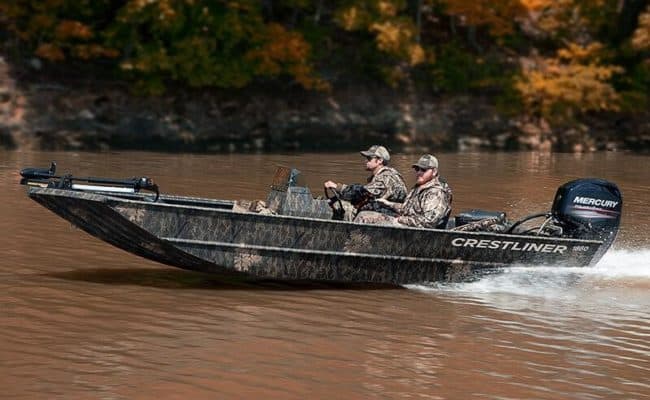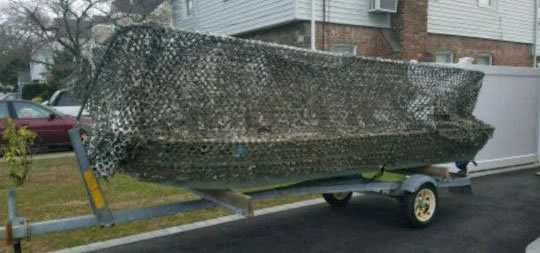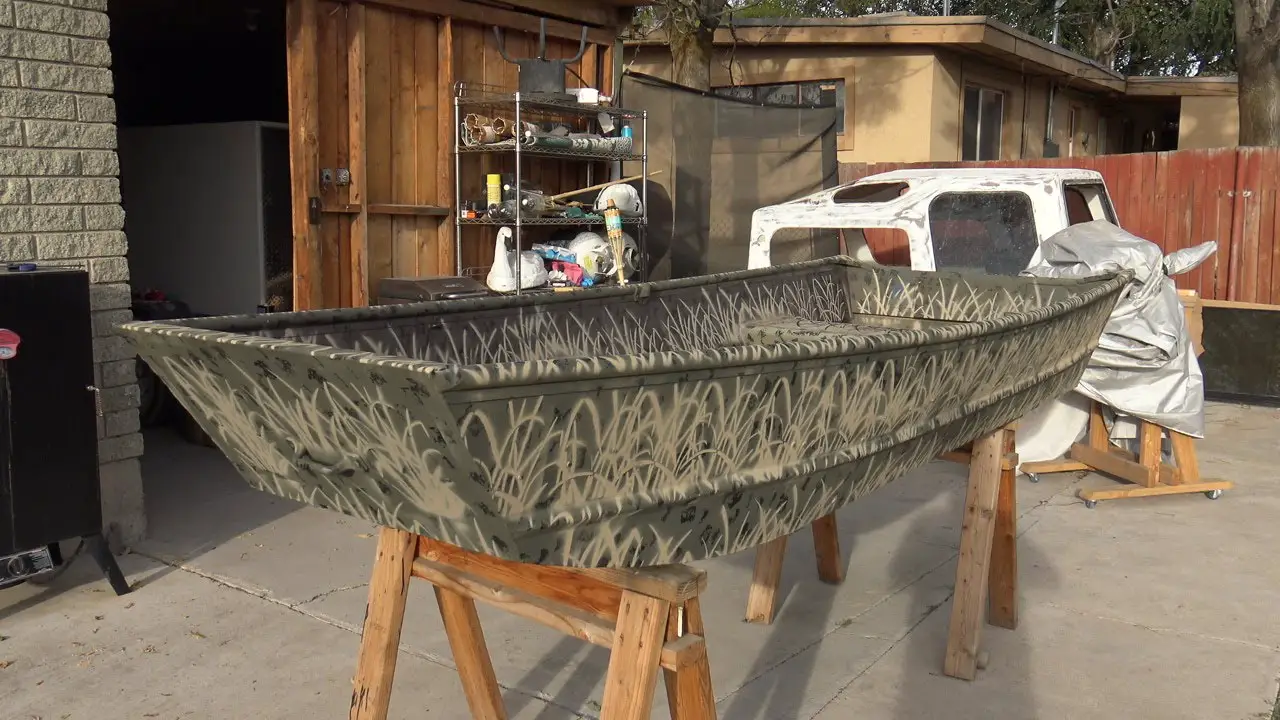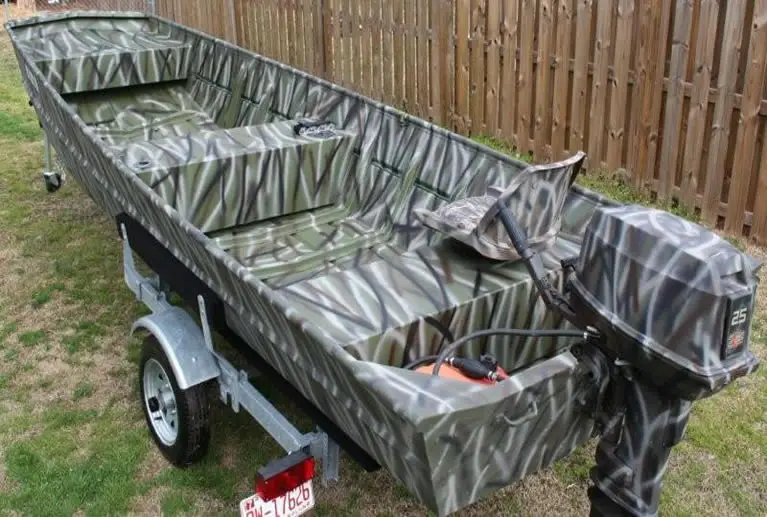I use a Jon boat as an example for these boat camouflage techniques. You can use them on any boat you own.
Contents
Why it’s sometimes a good idea to camo a Jon boat
Jon boats are very popular shallow water vessels that are used for a variety of purposes.
For the most part a Jon boat can be used straight “out-of-the-box” but for certain owners some modifications are desirable.

If you are a fowler and want to camouflage your Jon boat then you’ve come to the right place.
How do you camouflage your Jon boat?
The most common ways to camo a boat is using wraps, camo cover and camo paint though there are also other means of completing the job.
For instance using natural camo is often very effective as your boat will closely resemble elements of the local environment.
The Jon boat is an ideal choice for fishing, hunting and recreational use in shallow inland waters.
Its practical and simple design makes it an easy to navigate vessel.
These simple flat bottomed boats have been popular with anglers and waterfowl hunters for well over a century. This is because they can be used to access very shallow waters and offer amazing stability in calm waters even permitting standing up in the boat without fear of capsizing.
Their small size and ease of handling mean that they can handle small waterways where water is also very shallow – the type of environments that are ideal habitats for a range of prey.
Another advantage is that the small outboard motor can be turned off and the rudder lifted from the water to allow for manual propulsion.
The poling and paddle capability offered by a Jon boat makes it the ideal vessel for the huntsman who requires a quiet approach to hunting grounds.
However, these advantages are not enough when it comes to waterfowling.
For hunting it is advisable to camouflage your boat so it blends in with the environment.
Mastering the art of camouflage is critical to any success in waterfowl hunting.
Even when your boat is well equipped a lack of camouflage may mean going home empty handed as waterfowl have high visual acuity and are incredibly discerning.
If they know you are present the hunt is over.
The time, effort and preparation that you put into concealing your Jon boat will give you that extra edge over the ducks and geese you are hunting.
Bayous, lakes, rivers and creeks can be successfully navigated by stealth when camouflaged. You can be confident that your Jon boat will evade the attention of any potential prey as long as you remain fairly quiet.
How to create a camo Jon boat using mods
Seasoned huntsmen will probably see a range of remarkably well concealed boats on the water throughout the hunting season.
No two boats every really look alike unless they are store-bought camo vessels.
If you see a camo Jon boat on the water, it likely wasn’t bought that way.
Most boat camouflage jobs were done at home.
With such a range of camos available it can be difficult to decide on which route to take when you want to camouflage your own boat for the first time.
But the good news is that concealing your boat does not need to be exorbitantly expensive.
It does require some thought and a little bit of money though if you want to do the job right.
Depending on how and where you will be using your boat a range of concealment options and techniques are available.

Boat camouflage blinds are the easy solution
A boat can readily be turned into an effective duck blind with a lightweight aluminum frame from which camo netting can be suspended to drape over the entire boat.
Standard camo blinds, like these ones, or a full thatch blind kit like this, work really well for making your boat blend into the environment.
Some blinds may also utilize die-cut designs for a 3D effect.
Standard blinds (netting) usually require some additional natural material (see natural cover below) to aid concealment and are often easily bent or broken.
It is often a good idea to go with a kit rather than just buying the netting otherwise you will need to construct your own frame for hanging it.
Boat camouflage wraps are the more permanent way to camouflage a boat
Boats wraps are decals. These vinyl decals feature a range of complex camo designs that mimic natural foliage and water tones.
Boat wraps, like this dark camo one, can be purchased in rolls and applied to you boat in strips.
Others come as pre-cut panels in the dimensions of your Jon boat and applied manually with a squeegee and finished with a heat gun and edge sealer.
Jon boat camo covers
Camo covers are an effective way of concealing the contents of your boat. Remember ducks don’t just see the boat they also see what is inside the boat.
Camo covers have camo pattern designs on them and can be used for just about everything in your boat.
You can use them to cover the boat itself, the seats and everything in between – right down to your phone!
Camo covers come in the form of netting which can usually be stretched over the entire boat.
Other types of camo covers can be bought for specific items such as your outboard motor, seats and accessories.
See a range of camo covers here.
Use natural cover to cloak your Jon boat
A natural cover is one of the most effective and cheap ways of concealing your Jon boat.
It however requires imagination and a bit of effort to construct.
Natural cover explained
A natural cover is a blind or form of concealment comprised of natural elements from the local environment.
Experienced hunters will often construct a natural cover or makeshift blind from materials in the environment around their hunting grounds.
Mud, sticks, reeds, branches, brush and cane can be assembled into something that completely conceals your boat but that looks authentic for the area in which you hunt.
Because natural cover is made from elements in the hunting environment such camo is often much more effective than a store bought alternative.
It does take some time to construct this camo though and, for obvious reasons, due to decomposition of the materials it needs to be rebuilt regularly.
Natural cover is often a good accompaniment to the other methods of camouflage mentioned in this post rather than being a sole means of camouflaging your boat.
Using decoys as natural camo
Placing decoys around your Jon boat can contribute to its concealment.
However be aware that leaving a decoy in the same position for a prolonged period looks unnatural to prey and will probably give you away.
Using paint: how to camo a boat in 8 steps
Painting your Jon boat may seem an arduous task but if you are looking for ways to camouflage it permanently this is probably one of the most accessible techniques you could use.
One of the great advantages of camo painting is that you can tailor your color scheme exactly to the waterways you will be traversing.
Even without precision and artistic flair you can obtain results that are good enough to properly conceal your boat.

Your boat will require painting inside and out.
A thorough paint job offers the best opportunity to evade detection on the water.
Use the following methodical approach for the best results:
1. Elevate your boat
Obviously your boat needs to be out of the water.
Use boat stands or bricks to get your boat off the ground.
2. Sand down your boat
Sanding will provide and even surface for your paint to ‘stick’. Sanding is not just for wooden boats!
Start with the boat interior and work your way to the exterior – remember both the inside and the outside of your boat needs camouflaged.
If your Jon boat is made from aluminum try scuffing surfaces with a wire brush on the end of a drill to ensure that paint will stick to the metal surface.
3. Clean the boat
Use hot soapy water to thoroughly scrub down your boat.
Clean the boat interior then the exterior with a hard brush, rinse and ensure that the boat is dried thoroughly before moving on to the next step.
4. Apply a good primer to all boat surfaces
Waterproof primer provides an additional layer of protection for the boat and enhances the finish of your paint job.
It also forms a solid base for your camo paint.
For optimum protection be sure to choose a marine-grade primer that has been specifically developed for use on boats.
5. Choose or create stencils for your paint job
Marsh grass and cattails are typical patterns used. Alternatively, use an abstract traditional camo pattern.
There are a range of different camo styles to choose from with stencils to match.
Be sure to browse through a range of different stencil designs so you can find one that best matches the environment in which you will hunt.
Here are a range of different stencil camo designs to choose from.
6. Decide on the right color scheme for your Jon boat
Earthy or marine oriented tones will work best on the water.
Think browns, olives, mud and sand shades as well as blue and grey hues.
Some hunters simply paint their boat the color of muddy water or dull vegetation and then add additional physical camouflaging such as netting or covers.
This type of marine enamel paint is a good choice of paint which comes in a variety of tones.
There are also some specific brands of duck boat and Jon boat paint available.
7. Go light to dark
Start painting with the lightest color first and work through to the darkest tones ensuring each application has dried before moving to the new paint color.
The entire boat should be painted in the lightest color first with your stenciling used with the darker tones later.
Avoid working in the cold as this affects the spreading of the paint and its drying.
Spray painting works best.
8. Clear coat it
Complete your paint job with a final clear coat finish.
This will seal your Jon boat camo design and protect it from wearing away.
How to camouflage using paint (video instructions)
Beyond the initial camo – ensuring that you are truly, fully camouflaged
You will find that everyone has their own approach to camouflaging their boat.
The key is to find, by experience, what will work best for you and the specific environment in which you hunt.
Unfortunately, the keen eyesight and survival instincts of waterfowl are such that it takes very little to give you away.
So, leave nothing to chance with your prey and don’t waste an excellent Jon boat camo job by not being fully camouflaged yourself!
Using camo clothing, face paint, hoods, and ensuring all your gear is properly camouflaged will give you the advantage.

